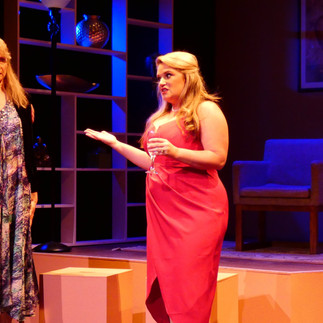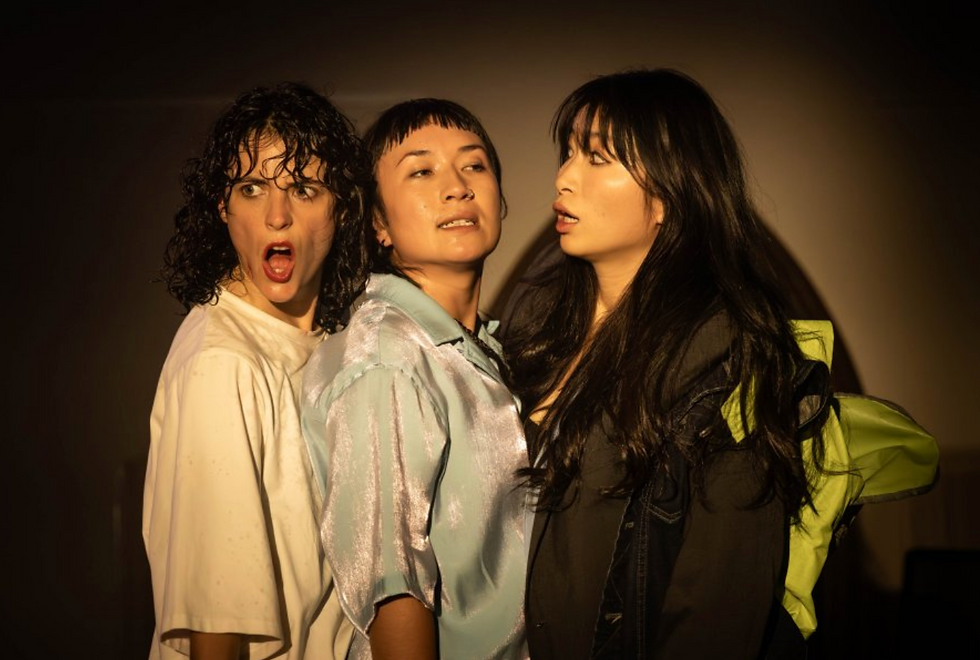Review: When Dad Married Fury at Clayton Community Centre – Encore Theatre
- Theatre Travels

- Oct 17, 2022
- 6 min read
Review By Ellis Koch
The basic plot: Rich and conservative dad Alan marries a young, American, fundamentalist Christian woman, Fury, much to the dismay of his two sons, Ben and Ian, who fear for their inheritance.
Overall, When Dad Married Fury is a comedy. At least, it does make you laugh in places, but there are some serious issues going on in this play: Racism, misogyny, greed. Most of the characters, with the exception of two, are reprehensible. The main character, Alan, is a vile, selfish, self-serving man who has indirectly caused the death of another man, and possibly others, through his own greed and callousness. His two sons are small minded men who have inherited their father's greed. Fury is sweet but she's a right-wing fundamentalist Christian with everything that comes with that title. Ian's wife Sue, is shallow and wilfully follows her husband's simpering plan to get Alan's millions. Only Ben's wife Laura, and her mother, Judy, are in any way likeable. And while I wouldn't generally spend so much time describing the characters of a play I feel it is necessary in this instance because, when more than half of the characters are horrible people you have to work at making then presentable to the audience. Unfortunately Encore Theatre's production only manages to get this right a few times throughout. But let's start with design . . .
The set, designed by Neil Barnett, was elegant in design - an executive style apartment on a raised stage to the back left and another similar space to the back right with both spaces connected by a smaller, raised platform functioning as a step at back centre. Four free standing cubes were placed on the lower part of the stage at the front and functioned as seats for the actors during various scenes. A large projection screen took up centre back and displayed photo imagery to give a sense of the locational changes of each scene.
The set was well made (Bill Rendall, Lance Wheatland, Richard Ridler, Ian McCormick and Len Richardson) and quite prominent so it's odd that it was vastly under-utilised throughout the play. Most of the action took place in front of the set and resulted in the actors often finding themselves standing in a static line. There could have been a greater use of even just the smaller, raised step to add some dynamic positioning of the actors. Depth and height are critical to presenting differences of power and vulnerability on stage and this was sorely lacking in all but one or two scenes during Act Two. The design itself, while functional and nice to look at, did nothing to indicate the difference in status or situation of the characters - Judy's apartment, for example, bore the same elegant design as the opposing apartment in spite of her husband dying penniless due to getting fleeced by Alan. This part of the set just didn't suit the character it was presenting to us.
The projection screen could have been an interesting way of conveying location - and while it did serve this function the images used (courtesy of Stephanie Hutton) were of odd perspectives and just looked like stock photos taken from the internet. There was a strange quality about them that cheapened the set rather than enhanced it and as a result we could have done without them. Audiences are pretty savvy and don't necessarily need every locational change spelled out to them.
Act One seems to have a few quick vignette style scenes but unfortunately the changes between them were a little clunky with actors still lit as they left the stage. Actors were also responsible for bringing on extra set pieces and this also slowed the transitions down somewhat. While I could see what director Damian Jones was going for I do not think the pace or sharpness of these transitions worked the way he may have wanted them to. The inclusion of music (Tim Long) in between the locational changes was, at first, interesting but quickly lost its charm as the vignettes rolled past.
Lighting design, by Deryk Hartwick, was nice and effective. Soft blue in the out of focus sections and warm lamps for in focus. Decently lit, with smooth lighting transitions by Alex O'Neill. Separate states for each part of the stage which provided nice isolation. Some strange shadows across actors’ faces in Act Two but nothing too distracting.
Out of a cast of seven there were three standouts;
Tim Byron, who played Alan, treated us to a consistent, solid portrayal of a rich, Aussie businessman. His energy helped to lift every scene he was in and he had an ease of delivery that was most welcome. He had the task of delivering some fairly off-colour lines but still managed to bring a sense of charm to the role that gave Alan a sociopathic edge. My one desire was to see him give us a little bit more bite on some of the less savoury lines. To have him indulge in Alan's vileness just a little bit.
Michelle Tanner as Laura, the Left leaning wife of Ben, was another refreshing burst of energy every time she was on stage. Her acerbic retorts to Alan and Fury during Alan's birthday scene were delightful and delivered with excellent comedic timing. Tanner has a good emotive range without being over the top and this works well with her smooth, natural delivery of her lines. This was a critical role, in my opinion, as Laura is only one of two characters with any shred of decency and presents a good foil to the artificial happiness and Right-wing beliefs of Alan, Fury and the other family members. Tanner pulls this off without a hitch.
Britni Leslie as the titular Fury is wonderfully saccharine, irksome and overbearing. Her appearance marked a turning point for the production and helped uplift the flagging energy in the first half. Her dialogue comes out with decent pace and liveliness and her sincerity as Fury, even when delivering anti-gay, classist and racist rhetoric is notable.
Chris Grant played Ian and was capable though inconsistent in the role. I'm not sure if it was nerves or just an off night but he seemed self-conscious at times - his dialogue and movements appeared stiff and over rehearsed and sometimes there was a lack of connection with what he was saying. There were moments, however, where he was more focused, relaxed and engrossed in what he was doing which made him much more interesting to watch.
Chris Dossor gave us a bit of a contrived performance as Ben - everything seemed a little too melodramatic and one-dimensional. There seemed to be a lack of connection with his dialogue and what was at stake for Ben and his wife. There was also a fair bit of exhalation going on that I think may have been trying to mask and make up for this lack of connection with what he was saying. Ultimately I felt as though I was watching Chris on stage, not Ben.
Kirsty Hall had the thinnest role as Sue, Ian's wife, and the thankless task of making it interesting. I think she did a good job with what she had but ultimately the character was not very well fleshed out by Williamson, which is no fault of Kirsty's.
Joan Krutli played Judy, mother to Laura. Krutli definitely had one of the most interesting roles of the play but lacked the gravitas to pull it off. There is a lot real-world tragedy to the character of Judy, a woman whose husband killed himself due to being swindled out of their lifesavings by Alan, which was sadly missed. I want to note that I think this missed beat is in part due to a lack of solid direction from Damian Jones in regards to the more dramatic elements of the script.
I cannot understate how much a lack of dynamic staging of the actors really robbed the production of life. Even some of the stronger actors were, at times, rendered a bit lifeless due to the static nature of Damian Jones' blocking decisions. To act is to do - to perform an action. It is very much a strong part of theatre and without it we lose a certain energy that is integral to the believability and success of any production. In Act One there is an argument during Alan's birthday that builds to a crescendo and is eventually arrested with a reveal - and while Tim Byron, Michelle Tanner and Britni Leslie do great work in building this up, the arresting moment fizzles due to average staging - which is actually slightly stronger in this scene than any other - and some less focused and energetic performances from some of the other actors. This lack of dynamics in the blocking throughout the play means we lose some of the power of the character interactions, and little thought appears to have been put into how stage space can enhance power dynamics and interactions between characters.
What could have been an interesting mix of comedy amidst drama instead comes out solely as a flat, colourless comedy let down by some linear staging, clunky scene transitions and some individual performances that were not quite up to the task of straddling both the comedic and the dramatic.
Images Supplied










